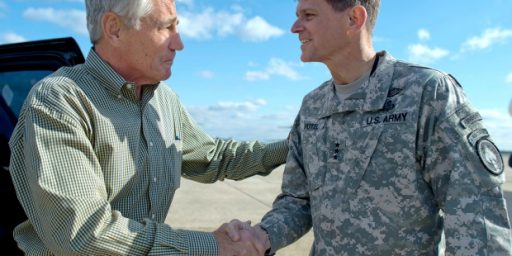Beating The Roadside Bombers
U.S News has a fascinating feature on how the Pentagon is working to train soldiers how to deal with IEDs.
Beating The Roadside Bombers: How the Pentagon is fighting back against Iraqi insurgents’ most lethal weapon (U.S. News & World Report, May 9)
[…] The nerve center of the military’s efforts to stop the bombings lies in a humble set of offices deep in the basement of the Pentagon. Officers have pushed together cast-off desks to create a makeshift conference table, and the rest of the furniture looks like it was grabbed from a yard sale. This is home of the Joint IED Defeat Task Force. Originally formed in October 2003 as an Army organization, it has since been expanded to include representatives of each of the major military services, as well as Britain’s defense forces.
Initially, the task force’s priority was to develop tactical changes to lower the risk of bombing injuries. Take, for example, the lowly fuel can. Until spring 2004, it was common to see fuel cans on the back of humvees, says Lt. Col. Ernie Benner, the task force’s operation officer. But if the vehicle was hit with an IED, the fuel cans would ignite, increasing the likelihood of casualties. “If you look now, you won’t see fuel cans,” says Benner. “Once you point that out, it is instantaneous, you see the idea spread.” Further, the task force spent much of last year pushing new technologies to help soldiers survive bombings. They accelerated efforts to add armor to humvees and expand the use of electronic jammers that can block IED s from being detonated remotely. Task force officials say those innovations have had an effect. Chances of surviving an IED attack have risen dramatically. From April 2004 to February of this year, although the number of roadside bombs increased, the number of casualties per explosion declined by nearly half, according to the task force.
But there’s a limit to what technology can do, Benner says. Insurgents can counter technological innovation: Bigger bombs overcome the armor on a humvee. Changing trigger mechanisms can render jammers useless. And there is evidence that insurgents have evolved in an effort to maintain their lethality. “There is no silver bullet,” says Brig. Gen. Joseph Votel, the IED task force director. “Any technology we provide will not match the brain of an adaptive enemy.”
Late last year, as the limits of technology became more apparent, the task force began to emphasize a new strategy, focused less on surviving or stopping an individual bomb and more on targeting the bomb makers. The military calls it working “to the left of boom” –that is, before the explosion. “When you work against people,” says Benner, “you work on offensive and you have a greater effect.”
To help them take the offensive, the military has examined how conventional forces have dealt with bombing campaigns in other fights, including the Israeli-Palestinian conflict and the Vietnam War. The task force’s British officers, based on their nation’s experience in Northern Ireland, have emphasized that American military units need to learn more investigative techniques and act more like police detectives. American brigades in Iraq now collect information about every bomb: Where was it located, when did it detonate, what kind of bomb was it? From that information, the task force wants the brigades to find patterns that can help determine which bomber planted a bomb, where that bomber is based, and when he might strike again. “We are using the same techniques a policeman would use: analysis, circumstantial details, what is left behind,” Votel says. “Every IED tells a story, and we have to be able to decipher it.”
For the campaign to work, it requires every soldier to act like a sensor, gathering intelligence every time he leaves his base. To accomplish that requires improving soldiers’ training prior to deployment to Iraq. The training gap is particularly acute for the National Guard and reserve units that currently make up about 40 percent of the forces in Iraq. At Camp Shelby, National Guard units spend five months learning the skills they need to survive in Iraq. And the No. 1 skill is avoiding, and stopping, roadside bombs. “The IED threat is ubiquitous,” says Col. Daniel Zajac, the commander of the Training Support Brigade at Camp Shelby. “The only way you raise [soldiers’] awareness is if they believe they can be killed.”
[…]
The technological improvements, systemic intelligence analysis, immersive training, and offensive posture are making a difference, Votel says. After a spike in IED deaths in January and February, the numbers declined in March and April. Military officers hope they are seeing the beginning of a trend, but they caution that the battle is far from won. “We have made progress; we have a ways to go,” says Votel. “There are a lot of soldiers who are still being hurt.”
While the learning curve seems excruciatingly slow watching it unfold on television–not to mention as hundreds of soldiers die during the process–it’s really amazing how quickly our forces adapt to new challenges. Certainly, the enemy adapts its tactics as well. But it’s telling that most of the attacks in recent months have been against softer Iraqi targets rather than American formations.






“The technological improvements, systemic intelligence analysis, immersive training, and offensive posture are making a difference, Votel says. After a spike in IED deaths in January and February, the numbers declined in March and April.”
200 dead in May so far including at least 17 US personnel….some improvemnent.